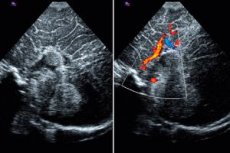New publications
An ultrasound corridor to the brain for diagnosis and treatment has been created
Last reviewed: 02.07.2025

All iLive content is medically reviewed or fact checked to ensure as much factual accuracy as possible.
We have strict sourcing guidelines and only link to reputable media sites, academic research institutions and, whenever possible, medically peer reviewed studies. Note that the numbers in parentheses ([1], [2], etc.) are clickable links to these studies.
If you feel that any of our content is inaccurate, out-of-date, or otherwise questionable, please select it and press Ctrl + Enter.

Modern surgical interventions can be performed with minimal tissue damage using an ultrasonic surgical instrument. But in the case of brain pathologies, ultrasound could not be used before, since the cranium prevented the penetration of rays.
To eliminate this problem, a group of specialists representing the American University of California in Riverside came up with a unique ultrasound corridor that allows the rays to enter directly into the patient’s brain.
Ultrasound streams can be used both for examination of structural defects of the brain and for combating tumors, Parkinson's and Alzheimer's diseases, for eliminating thromboembolism of cerebral arteries, and also for episodic removal of the blood-brain barrier for the administration of medications.
Until now, doctors could only perform neurosonography on infants until the only natural passage for ultrasound – the fontanelle of the cranial vault – was open. After that, the procedure became potentially impossible.
Experts explain: cranial bones have increased density, despite the fact that their thickness fluctuates within 2-8 mm. For an ultrasound wave, this is an insurmountable obstacle.
The artificial ultrasound corridor is a transparent ceramic window that neurosurgeons sew under the scalp to replace the small area of the parietal bone that was removed. The window is made of yttrium-normalized zirconium dioxide and has a dense structure that allows ultrasound to pass through without obstruction.
Ceramic-based elements have already been recognized as very promising in the medical field. They are biologically compatible, practical and shock-resistant - thus, ceramics are an ideal analogue of the cranial bone. The new material can be used for both ultrasound and laser treatment.
"Ceramics are already actively used in dentistry and arthrology: dental crowns and prostheses are made from it. Our goal in this situation is to create a therapeutic corridor, with the help of which doctors will be able to carry out numerous ultrasound procedures on the brain - both therapeutic and diagnostic," the author of the discovery points out.
If the ceramic window has the appropriate optical and radiofrequency characteristics, then this will really allow the use of ultrasound surgery for performing interventions on the brain. In addition, today there are serious prerequisites for establishing control of the blood-brain barrier using ultrasound - after all, so far the only barrier to this has been the cranial bone.
"Zirconium dioxide is rightly called "steel ceramics". It is an extremely durable material with low porosity - a unique property that is ideal for diagnostic procedures and ultrasound treatment of neurological pathologies," the experts say.

 [
[